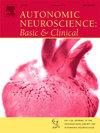Hypothalamic excitatory input to AT1AR and TH expressing neurons of the nucleus of the solitary tract in mice
IF 3.3
4区 医学
Q2 NEUROSCIENCES
引用次数: 0
Abstract
Autonomic reflexes are modified during development or in response to specific physiological challenges and disease. One modulating region is the hypothalamic paraventricular nucleus (PVN), whose neurons project to the nucleus of the solitary tract (NTS) to modulate viscerosensory input. Yet the neural circuitry by which this is achieved remains ill-defined. Adeno-associated virus was injected into the hypothalamus of TH-GFP or angiotensin type 1A receptor (AT1AR)-GFP mice to drive channel rhodopsin 2 (ChR2) expression. Whole-cell recordings of NTS neurons in close proximity to labelled hypothalamic efferents were made in horizontal slices of the brainstem, allowing activation of both hypothalamic and viscerosensory inputs. Most neurons recorded did not exhibit ChR2-mediated responses, despite extensive hypothalamic axon/terminal labelling. In some NTS neurons, ChR2-mediated stimulation of hypothalamic efferents elicited glutamatergic, AMPA receptor mediated excitatory postsynaptic currents (ChR2-EPSCs). Responsive NTS neurons included both 2nd, and higher, order neurons and AT1AR and few TH expressing neurons. All ChR2-EPSCs tested were blocked by TTX. Some TTX blocked ChR2-EPSCs could be recovered with the co-application 4AP, confirming monosynaptic connection between hypothalamic and NTS neurons. Superimposition of convergent inputs from hypothalamic and viscerosensory efferents resulted in summated EPSCs that would likely increase throughput probability of the viscerosensory signals at NTS neurons. The neural link between the hypothalamus and NTS comprises discreet glutamatergic input, including to TH positive and AT1AR expressing NTS neurons.
小鼠下丘脑对孤立束核AT1AR和TH表达神经元的兴奋性输入
自主神经反射在发育过程中或对特定生理挑战和疾病的反应中发生改变。其中一个调节区域是下丘脑室旁核(PVN),其神经元投射到孤立束核(NTS)以调节脏器感觉输入。然而,实现这一目标的神经回路仍然不明确。将腺相关病毒注入TH-GFP或血管紧张素1A型受体(AT1AR)-GFP小鼠下丘脑,驱动通道视紫红质2 (ChR2)的表达。在脑干水平切片上对靠近标记下丘脑传出信号的NTS神经元进行全细胞记录,从而激活下丘脑和内脏感觉输入。尽管有广泛的下丘脑轴突/末端标记,但大多数记录的神经元没有表现出chr2介导的反应。在一些NTS神经元中,chr2介导的下丘脑传入刺激引发谷氨酸能、AMPA受体介导的兴奋性突触后电流(ChR2-EPSCs)。响应性NTS神经元包括第二阶和更高阶神经元、AT1AR和少数表达TH的神经元。所有ChR2-EPSCs均被TTX阻断。一些TTX阻断的ChR2-EPSCs可以通过4AP的联合应用得到恢复,证实下丘脑和NTS神经元之间存在单突触连接。下丘脑和内脏感觉传入信号的聚合输入叠加导致epsc的累积,这可能会增加内脏感觉信号在NTS神经元的吞吐量概率。下丘脑和NTS之间的神经连接包括谨慎的谷氨酸能输入,包括TH阳性和AT1AR表达的NTS神经元。
本文章由计算机程序翻译,如有差异,请以英文原文为准。
求助全文
约1分钟内获得全文
求助全文
来源期刊
CiteScore
5.80
自引率
7.40%
发文量
83
审稿时长
66 days
期刊介绍:
This is an international journal with broad coverage of all aspects of the autonomic nervous system in man and animals. The main areas of interest include the innervation of blood vessels and viscera, autonomic ganglia, efferent and afferent autonomic pathways, and autonomic nuclei and pathways in the central nervous system.
The Editors will consider papers that deal with any aspect of the autonomic nervous system, including structure, physiology, pharmacology, biochemistry, development, evolution, ageing, behavioural aspects, integrative role and influence on emotional and physical states of the body. Interdisciplinary studies will be encouraged. Studies dealing with human pathology will be also welcome.

 求助内容:
求助内容: 应助结果提醒方式:
应助结果提醒方式:


